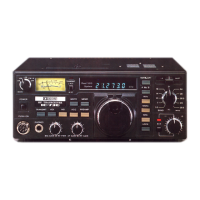3 - 2 TRANSMITTING CIRCUITS
3 - 2
-1
AF
CIRCUITS
The audio signal
from
the
microphone
is
fed
to
pin
3
of
IC4, operational
amplifier
on
the
MAIN
unit,
through
the
MIC
GAIN
control
R14-2 on the
front
panel.
The
amplified
AF
signal
is
put
out
from
pin
1,
then
fed
to
pin
5
of
the
balanced
modulator,
IC2
in
the
OET
unit,
which
is
the
same
one
for
the receiver
product
detector.
To
pin
7,
the
BFa
signal
is
fed and
mixed
with
the
audio
signal, and a
9.013MHz
or
9.010MHz
modulated
OSB
(carrier suppressed
double side band) signal
is
put
out
from
pin
3.
In the receive
mode
and
SSB
transmit
mode,
bias voltages
adjusted
by
R44 and
R45
are applied
to
pins 5 and 7 res-
pectively
to
place
IC2
in a carrier
null
condition.
In
the
·AM
and
CW
transmit
modes,
06
is
turned
OFF
and
an
off-
set voltage
is
applied
to
pin
5
through
04.
Thus
IC2
is
in
an
unbalanced
condition
and a
9.0115MHz
AM
signal
or
carrier
is
put
out
from
pin
3.
In
the
other
modes,
06
is
turned
ON and the
offset
voltage
is
shunted
to
the
ground
and IC2
is
in a balanced
condition.
In the receive mode and CW
transmit
mode,
05
is
turned
ON and shunts the
AF
signal
from
the
microphone
to
ground
to
prevent the
AF
signal
is
applied
to
IC2.
3 - 2 - 2
IF
CIRCUITS
The signal
output
from
IC2 in the
OET
unit
is
fed
to
the
1 st gate
of
03,
mixer,
the
same
one
for
receive
3rd
mixer,
through
03
in the
MAIN
unit
to
be
converted
into
a
455kHz
signal.
The
local
oscillator
for
this
mixer
is
also
the
same
one
for
the receive. However, the
oscillation
fre-
quency
is
fixed
at
9.4665MHz.
In the receive mode,
02
is
turned
ON and shunts
the
signal
fed
from
the
OET
unit
to
ground
to
prevent
the
signal
from
leaking
into
the receiver I F circuits.
In the
SSB
and CW modes, the
455kHz
signal
is
fed
to
Fll,
MF-455-11GZ
(or
-llAZ),
mechanical
filter
which
has
a
2.4kHz
bandwidth,
to
remove
unwanted
sideband signal.
In
the
AM
mode, the
455kHz
AM
signal
is
fed
to
FI2,
CWF455HT,
ceramic
filter
which
has
a
6kHz
bandwidth,
and the signal
passes
through
the
filter
unchanged.
The
output
from
the selected
filter
is
then
fed
to
the
balanced
mixer
consisting
of
04
and
05
which
is
the
same
one used in the receiver's
4th
mixer.
The
mixer's
porpuse
is
to
convert
the
incoming
signal
to
9.0115MHz.
The
9.0115
MHz
signal
is
then fed
to
the I F
amplifier
09.
In the CW mode and
key-up
condition,
a positive voltage
is
applied
to
the source
of
09
through
019,
and
09
is
turned
off
and the signal
is
not
fed
to
the
next
stages. In key-
down
condition,
010
is
turned
ON and
the
positive voltage
applied
to
the source
is
shunted
to
ground
through
010.
Thus the positive voltage
is
not
applied,
09
functions
in
normal
condition
and the signal
is
amplified
then fed
to
the
next
stages.
The
amplified
I F signal
is
then fed
to
F
11,
9M
lOA
9.0115
3-4
MHz
crystal
filter
(or
installed
optional
crystal
filter)
in
the
2NO
I F
unit.
Then
the
signal
is
fed
to
the
doubly
balanced
mixer
con-
sisting
of
01
through
04,
which
is
the
same one used in the
receiver's
2nd
mixer.
In
this
case,
the
mixer's
purpose
is
to
convert
the
incoming
signal
to
39.7315MHz.
The
39.7315MHz
signal is fed
to
the
amplifier
07,
then
the
mixer
consisting
of
04
through
07,
which
is the
same
one
for
receiver 1 st
mixer,
for
conversion
to
the desired ope-
rating
frequency.
When
10MHz,
18MHz
or
24.5MHz
band
is
selected, a
po-
sitive voltage
is
applied
to
the
source
of
07
through
027,
026
or
025
respectively. This
turns
07
OF F and mutes
transmission on these bands.
To
transmit
on
these bands,
cut
lead
of
the
diode
for
the
desired band.
The
desired operating
frequency
signal
is
fed
to
the band-
pass
filter
to
produce a clean
output.
The
appropriate
filter
is
selected
with
the
BANO
switch.
The
signal
is
then
amplified
by
04
and fed
to
the
PA
unit.
3 - 2 - 3
RF
POWER
AMPLIFIER
CIRCUITS
The
transmit
signal fed
to
the
PA
unit
is
amplified
by
01
up
to
about
1
watt.
01
is
a class A
amplifier
and maintains
high
linearity.
L2
gives the
correct
phase signals
(180
degrees apart)
for
the push-pull
amplifier
02
and
03.
02
and
03
are
class
AB
amplifiers
and
amplify
the
signals
up
to
about
6 watts.
The
bases
of
02
and
03
are biased
by
means
of
the barrier
voltage set
by
01.
01
functions
as
temperature com-
pensator
for
02
and
03,
and
is
attached
to
the
case
of
02.
Negative feedback
by
Rand
C applied across each
collector
and
base
of
02
and
03,
provides
stablility
and broadband
characteristics.
L4,
a broadband
transformer
provides balanced
OC
feed
to
the collectors
of
02
and
03,
and
for
matching
the
collector-
to-{;ollector impedance.
Then the signal
is
fed
to
each
base
of
04
and
05
through
L4
secondary
for
impedance
matching
and
correct
phasing_
04
and
05
are class
AB
push-pull
amplifiers
which
produce
100
watts
output.
The
bases
of
04
and
05
are biased
for
class
AB
operation
by
the
emitter
voltage
of
06
which
is
controlled
by the
bamer
voltage
of
02.
02
voltage
is
adjusted
by
R21
to
give
proper
idling
current.
02
also
functions
as
a temperature compensator
to
prevent
runaway caused
by
heating, and
is
attached
to
the
case
of
04.
R17 and R18 are resistors
which
provide
negative feedback
from
L7. L7 samples
the
output
and provides
stablility
and
broadband characteristics.
for
free
by
RadioAmateur.eu

